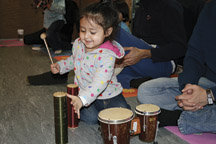The group is called Little Ustaads, which literally means Little Maestros. It’s the brainchild of director Kavita Bafana and her cofounder in Mumbai, Rachana Chandaria-Mamania. Bafana, who studied art history at Columbia and is an Indian classical dancer, teaches the Little Ustaads class in Jersey City.
Bafana grew up in New York City and was introduced to Indian classical music through kathak, a North Indian classical dance. “Growing up in New York, the opportunity to excel in Indian classical dance allowed me to connect to my Indian community,” Bafana said.
Little Ustaads offers play-based musical education classes for kids from age six months to five years, using peek-a-boo games and building blocks to help them learn.
Classes are held Sunday mornings at 20 River Court in the Newport section of Jersey City.
“The program has been running in Mumbai for two years with a total of 300 kids going through,” Bafana said. “In New York and New Jersey we started in May 2009 and have had 250 kids go through the program.”
“It’s very rewarding to hear them humming good quality Indian music.” Kavita Bafana
________
“The curriculum is designed to encourage children to appreciate Indian classical music through rhythmic tones, rich vocals, mini instruments, and vibrant visuals,” Bafana said.
“There was no program in India to teach Indian classical music to children under 6,” Bafana said. “Everything is Western music.”
Parents appreciate the uniqueness of a program that teaches Indian classical music to kids so young. “Sharing that with our children at an early age is truly beneficial,” one mother said. “The children are exposed to sounds that are different, they enjoy playing the instruments, they learn about counting beats, and begin to understand the concept of rhythm.”
East meets west
Bafana, who lives in Bergen County with her husband and twin 4-year-old boys, said, “We have a very rich cultural heritage, and we want them to be exposed to Indian music. Surrounded by Western influences, we face a difficult task of raising children that will embrace Indian culture.”
She’s been teaching for two years in Jersey City because of the large Indian community here.
“It’s a very welcoming area for me,” she said.
Before designing the curriculum, Bafana did her homework. “I went to music studios, music teachers, singers, and classical music teachers to get their valued opinion on how and what to teach,” she said. “I did a lot of research. The program is unique. It’s not from Bollywood. It’s super high quality music that adults would enjoy at the kids’ level.”
Her boys come to classes with her husband religiously every Sunday. “They’re growing up with music,” Bafana said. “It’s fabulous. They’re learning and understanding Hindi. They know numbers, songs, and all the Indian instruments. It’s very rewarding to hear them humming good quality Indian music.”
The Indian difference
Bafana offers a 101 on Indian classical music. “Major pieces are built upon ragas, or melodies, with five or more musical notes formulating different ragas,” she explained “Western music theory is built on do re me melodies.”
She said that rhythm and beats are called taal. In fact, the children are given a glossary of words to learn. For example, sargam is the understanding of Indian notation and pitch.
“Bollywood, which has its foundation in Indian classical music, doesn’t have much meaning for children,” Bafana said. “The adult topics are inappropriate for them. It’s nice to expose them to classical music where the topics are about friendship and nature, topics that are more relevant to children under the age of 5.”
Anup Jalota, a renowned Indian musician and classical singer, supports the philosophy of teaching music to toddlers. “This is the age where the natural talent of a child can be discovered,” she said. “Each child is born with a gift, and it is our job to realize it.”
In addition to songs, the kids learn about Indian instruments such as the sitar, the stringed instrument made popular by Ravi Shankar; tabla, a pair of hand drums or Indian percussion instruments; and basuri, a woodwind instrument. The children have miniature versions of these instruments.
“Their ears become sensitive to Indian instruments which wouldn’t happen otherwise because they don’t hear Indian music on a daily basis at home,” Bafana said. “It’s so beautiful that they are introduced to it at an early age.”
Open to all
You don’t have to be Indian to join the group but you do have to be between the ages of 6 months and 5 years.
The fee is $250 for 10 weeks. The classes max out at eight kids.
Find out about a free trial class. Call (773) 744-1662. E-mail newyork@littleustaads.com. Visit. www.littleustaads.com
Kate Rounds can be reached at krounds@hudsonreporter.com..
